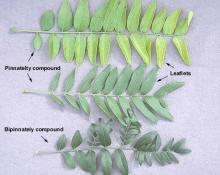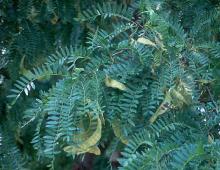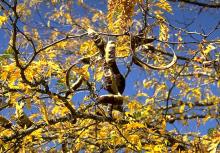Gleditsia triacanthos var. inermis
Common name:
Thornless Honeylocust
Pronunciation:
gle-DITS-ee-a tri-a-KAN-thos in-ER-mis
Family:
Fabaceae
Genus:
Type:
Broadleaf
Native to (or naturalized in) Oregon:
No
- Broadleaf deciduous tree, 30-70 ft (9-21 m), open, spreading crown, produces light airy shade, few if any spines (thorns) on the trunk or branches. Stems shining, smooth, and reddish to greenish-brown, distinctive zigzag form with enlarged nodes (appear as spur shoots); no terminal winter bud, about 5 small lateral buds at a node, more or distinct, some hidden below the bark. Leaves alternate, pinnately or bipinnately compound, 15-20 cm long, pubescent rachis, leaflets only 2.5-4 cm long. Flowers greenish-white, fruit are brown pods, 18-20 cm x 2.5 cm. Some cultivars are fruitless.
- Sun. Readily transplanted. Withstands a wide range of conditions, i.e., drought, high pH, salt. A good desert tree, but develops best on rich, moist bottomlands, or on soil of limestone origin.
- The honeylocust pod gall midge (Dasineura gleditchiae) deforms leaves in some areas, causing loss of ornamental value i.e., death of small branches.
- Hardy to USDA Zone 3 Species (Gleditsia triacanthos) native range from southwestern Ontario, Pennsylvania to Nebraska, south to Florida and Mississippi.
-
Two cultivars:
- 'Emerald Kascade' - very weeping habit, grafted to a standard, fruitless
- 'Sunburst' - popular, yellow new leaves that become bright green, fruitless
- Gleditsia: after German botanist Gottlieb Gleditsch; triacanthos: 3-spined; inermis: unarmed (without spines).
- Oregon State Univ. campus: parking lot west of Cordley Hall.
Click image to enlarge
















